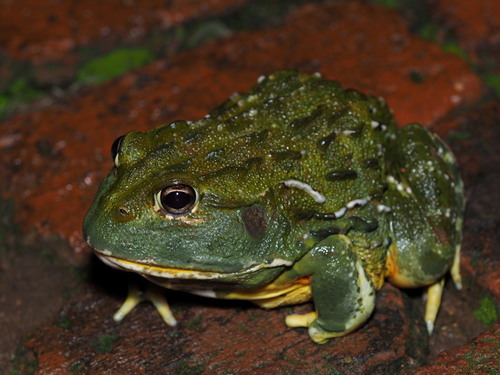
African Bullfrog
The African bullfrog (Pyxicephalus adspersus) is a hefty, burrowing creature of Africa's savannas. Known for its size and tenacity, it showcases unique parental care, with males vigilantly protecting their young. Its ecological role includes controlling insect populations, making it vital for its habitat's balance.
20-40 years
Lifespan
900.0 - 18000.0 g
Weight
Length: 11 - 25 cm
Size
Yellow, Cream, Olive, Light-Brown
Color
1.5-2 years
Age of Sexual Maturity
Least Concern
Conservation Status
Decreasing
Population Trend
Characteristics
The African bullfrog, Pyxicephalus adspersus, is a robust amphibian native to sub-Saharan Africa. It inhabits savannas and semi-arid regions, often burrowing to escape extreme weather. Notably large, it can weigh over a kilogram. This species exhibits remarkable parental care, with males fiercely guarding offspring.
Distribution Range of the African Bullfrog
Pyxicephalus adspersus, commonly known as the African bullfrog, is native to sub-Saharan Africa. Its geographical distribution includes countries such as Angola, Botswana, Kenya, Malawi, Mozambique, Namibia, South Africa, Tanzania, Uganda, Zambia, and Zimbabwe.
African Bullfrog's Habitat
Environmental Conditions
The African bullfrog typically inhabits savannas, grasslands, and open areas that experience seasonal rainfall. These regions are characterized by warm to hot temperatures, with a distinct wet and dry season. The species is often found in shallow, temporary water bodies like ponds, ditches, and rain-filled depressions that form during the rainy season.
Ecological Niche
The African bullfrog is a terrestrial amphibian that is well-adapted to arid and semi-arid environments. During the dry season, it burrows into the ground to aestivate, conserving moisture and surviving until the rains return. It is a carnivorous species, feeding on a variety of invertebrates and small vertebrates. Its ability to exploit temporary aquatic habitats and withstand dry periods allows it to thrive in its native range.
Copyright @ Nature Style Limited. All Rights Reserved.
 English
English